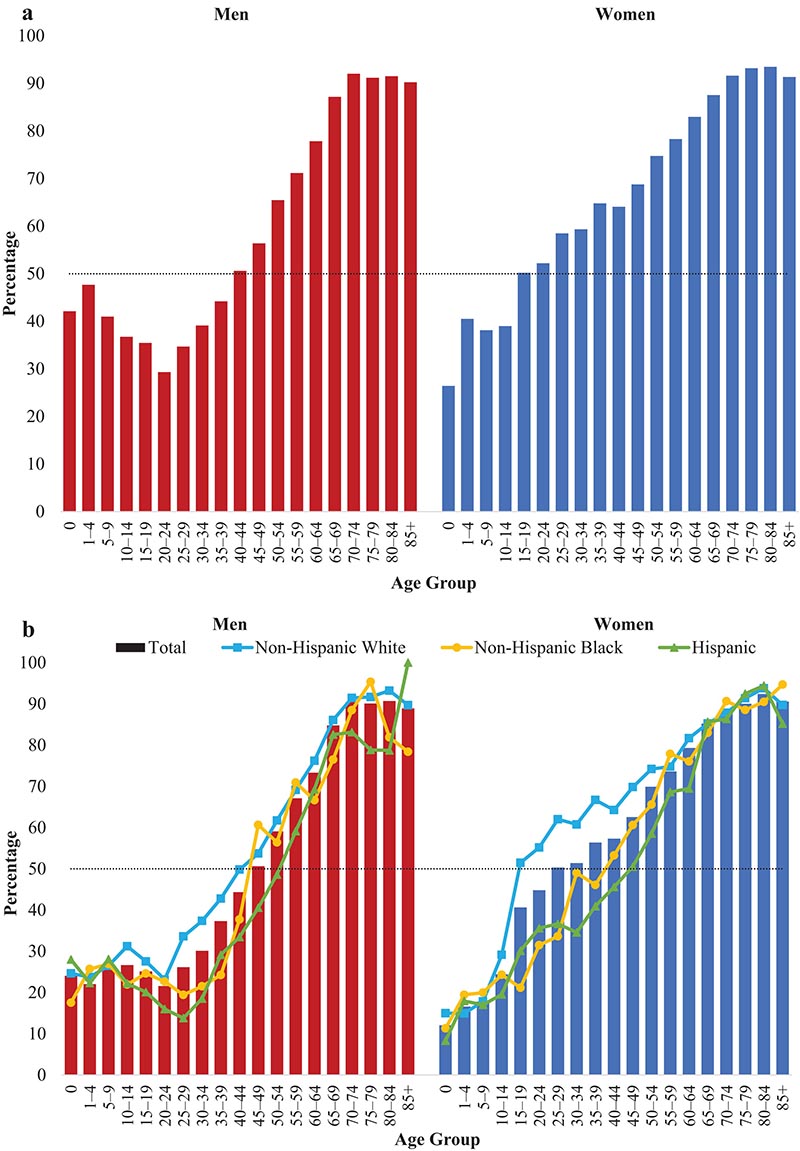Summary Prescription drug use has reached historic levels in the United States, a trend linked to increases in medicalization, institutional factors related to the pharmaceutical and healthcare industries, and the aging population and growing burden of chronic disease. Despite the high and increasing prevalence of use, there are no estimates of the total number of years Americans can expect to spend taking prescription medications over their lifetime. This study provides the first estimates of lifetime prescription drug use patterns using data from the 1996 to 2019 Medical Expenditure Panel Surveys, the Human Mortality Database, and the National Center for Health Statistics. . Newborns in 2019 could be expected to take prescription medications for about half of their lives: 47.54 years for women and 36.84 years for men . The number of years people can expect to take five or more medications has increased substantially. Americans also experienced particularly dramatic increases in years spent taking statins, antihypertensives, and antidepressants . There are also important differences in prescription drug use by race and ethnicity, with non-Hispanic whites using the most, Hispanics the least, and non-Hispanic blacks falling between these extremes. Americans are using drugs across a wide and growing swath of the life course, a testament to the centrality of prescription drugs in American lives today. |

Percentage of Americans taking (a) any prescription drug by age and sex and (b) key prescription drugs by age, sex, race, and ethnicity in 2019. Key prescription drugs are antineoplastics, biologic and immunological agents, cardiovascular agents, and of the CNS. , coagulation modifiers, gastrointestinal agents, genitourinary tract agents, hormones and hormonal modifiers, respiratory agents, psychotherapeutic agents and metabolic agents. The dotted horizontal line indicates the point at which more than 50% of the population in that age group is taking prescription medications. Source: Author’s analysis of MEPS data, 2019.
Comments
Americans born in recent years can probably count on taking prescription medications for about half their lives, according to new research.
For men born in 2019, it represents about 48% of their lives. For women, it’s 60% of their life, the study found.
"The years people can expect to spend taking prescription drugs are now higher than they could spend in their first marriage, getting an education or being in the workforce," said Jessica Ho, associate professor of sociology and demography at the University Penn State.
"It is important to recognize the central role that prescription drug use has taken on in our lives," Ho added in a university news release.
Ho studied this using surveys from the Agency for Healthcare Research and Quality (AHRQ) and the U.S. Centers for Disease Control and Prevention from 1996 to 2019. The surveys included information from about 15,000 households. elected annually. Information is collected every five months.
Nearly 70% of respondents allowed AHRQ and CDC to verify their prescriptions at their pharmacies, increasing accuracy.
Ho also used death data from the US National Center for Health Statistics and the Human Mortality Database to estimate how long Americans born in 2019 could expect to live.
It found that most American men take prescription medications by age 40. Most American women start taking prescription medications at age 15.
In 2019, a newborn boy could expect to take prescription medications for about 37 years, while a girl would take them for about 47.5 years.
"We see women starting to take prescription medications earlier than men, and some of that is related to birth control and hormonal contraceptives," Ho said.
"But it is also related to greater use of psychotherapeutic drugs and analgesics among women. If we consider the difference between men and women, excluding contraceptives would only account for about a third of the difference. The remaining two-thirds are mainly due to the use of contraceptives. other hormone-related drugs, pain relievers and psychotherapeutic drugs used to treat conditions such as depression, anxiety and ADHD [attention deficit hyperactivity disorder]," he added.
For men, the most common medications include statins and heart disease medications, but this varies by race. Black men have lower rates of statin use than white or Hispanic men.
"That’s concerning because we know that cardiovascular disease, diabetes and other metabolic disorders are very high among black men," Ho said.
Rates of polypharmacy (taking five or more prescription medications at once) are at high levels. While in the mid-1990s most people taking prescriptions only took one medication, they are now just as likely to take five or more.
The long-term effects of the newer drugs are unknown, Ho noted. And polypharmacy puts you at higher risk for drug interactions, side effects and poor outcomes, he said.
This use of prescription drugs also affects healthcare costs, which reached $335 billion in 2018 in the United States. Spending is projected to reach $875 billion by 2026. According to the report, about 14% of prescription drug spending is out-of-pocket costs.
"This article is not trying to say that prescription drug use is good or bad," Ho said. "Obviously, they have made a difference in the treatment of many conditions, but there is growing concern about how much is too much. There is a large body of research showing that Americans are less healthy and live shorter lives than our counterparts in other countries in the world. high incomes. "The issue of prescription drugs is an integral part of that reality. "What we found is that, even beyond what we might expect to see, rates of prescription drug use in the United States are extraordinarily high."
The US National Institutes of Health provided funding for this work. The findings were published October 1 in Demography.
















